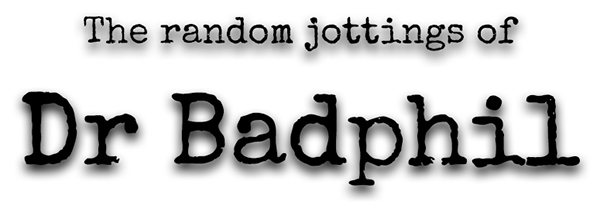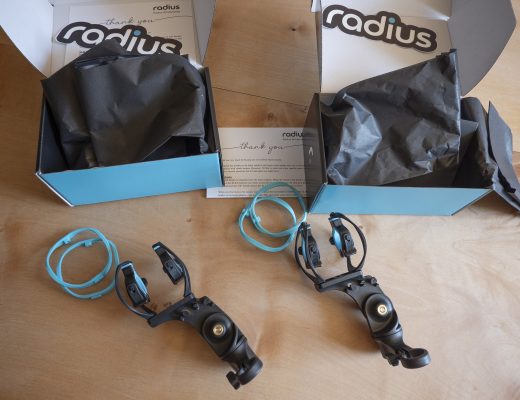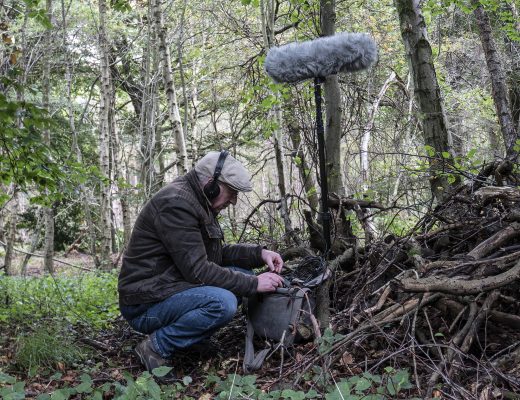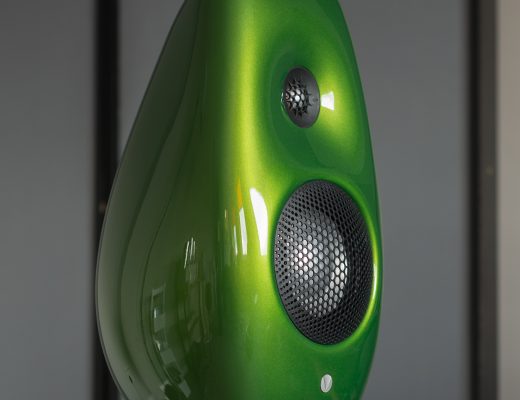
Introduction
A happy coincidence of an interesting recording project and the arrival, a few weeks ago, of a second MKH 8030 fig 8 mic from the folks at Sennheiser set me thinking. The recording was to be of the City of Norwich Pipe Band: that is bagpipes and drums (side/snare, tenor and bass). Pipe bands often play in a circle, so they can all see each other, and for this recording the plan was to maintain that approach in broad terms. The circular formation, with the band members’ backs to any audience has given the BBC’s sound engineers a challenge when recording the world pipe band championships outdoors in Scotland each year. At that event they are obliged to record outside the circle formed by the band (who, to make things yet more complicated for recording, march forward while playing before forming the circle), making the best of a difficult situation. For this recording, which was not in the context of a competition or, indeed, a public performance, I had the advantages of a static pipe band, being able to place mics inside the circle, and, also, being able to tweak that circle idea a little bit.
Both the recording of a pipe band and the recording a group of musicians in a circle, or near circle, are challenges, and in this case extra complexity was introduced since the overarching aim was to do two test sessions, one inside and one outside, as a prelude to possible recording of a CD (opinions generally are a little split on whether a pipe band should be heard/recorded indoors or, in its more natural habitat, outdoors). Rather than one overly long write up, I am breaking this down into separate blog posts: this first one explores the mic arrays used, and the second discusses the recordings from the indoor test (and includes samples of them).
Options for recording musicians in a circle
There are various ways to tackle recordings of a circle of musicians, with the end results ranging from mono to surround sound: in this case we were after stereo. Obvious options for such recordings would be a Blumlein pair or mid-side with two fig 8s; omni mid-side; double mid-side; and a spaced pair of omni mics. The last three options would work with a full circle (though omni mid-side suggests flattening the circle a little front and back, due to less sensitivity of the back-to-back cardioid pattern of the resultant, decoded, LR stereo pair). And the Blumlein pair or mid-side with two fig 8s options suggest modifying the circle to form two opposing arcs, say of 70-90 degrees each, avoiding any direct sound from the musicians in the more difficult (i.e, phasey) side quadrants. Choosing from these options is not easy as there are pros and cons. Blumlein or mid-side with two fig 8s (which mathematically decodes to Blumlein, but which inevitably sounds a little different) offer the prospect of excellent stereo imaging, albeit with the reversal of the rear side (not an issue in this or, indeed, many situations); omni mid-side and spaced omnis offer the prospect of a better low end (relevant here to the bass drum); and double mid-side offers the scope of having different mid-mic polar patterns front and rear and, more significantly, the option of changing respective levels in post (useful for tweaking the balance of the drums and the pipes on either side of the circle). Well, given that this was to be a test recording, the obvious solution was to do all of these options simultaneously. This didn’t require a proliferation of mics vying to be in the same place at the same time, but, rather, a simple set up of three mics in a pantophonic (i.e. horizontal, or 2D) native B-format (WXY) array for all the coincident mic options, flanked by a pair of omni mics to cover the spaced-pair option. So five mics in total.
Spaced pair
The spaced pair of omnis option hardly needs much explanation, as it will be familiar to most, if not all, readers: the key points here being aiming the mics upwards to get an even sound in all horizontal directions (omni polar patterns being increasingly directional at higher frequencies), deciding on setting the height (with no musicians behind others and wanting to get a balance between upwards projecting drones at the rear of the pipers and downwards pointing chanters at their fronts, and to avoid over dominance of the snare drums (or, in the first test, single snare drum), I settled on 1500mm), and choosing a spacing. For the latter, with the full circle I wanted a stereo recording angle (SRA) of 180 degrees, so that meant a spacing of 510mm or less: I went for 460mm. For the two arcs, however, it made sense to narrow the SRA to match a Blumlein pair (i.e. 76 degrees) so that meant a spacing of 840mm. And for the mics, not having two more MKH 8020s, I settled on a pair of Rycote OM-08 mics.

Coincident arrays: Blumlein, mid-side, double mid-side, and native B-format
The native B-format set up is likely to be less than familiar to many readers. B-format components (W, X, Y and Z) can be derived from the A-format outputs of the tetrahedral (or, indeed, octahedral) arrangements of ambisonic mics, such as the Soundfield. With ambisonic mics, the W, X and Y components (we can dispense with the Z or height component here as irrelevant to our stereo end product) are derived from combining the different capsules, creating three virtual mics – forwards and sideways facing fig 8s (X and Y respectively) and an omni (W). A native B-format set up, needless to say, just uses two real fig 8 mics and a real omni mic. The combination of mics allows all of the planned coincident arrangements to be achieved and, indeed, allows the array to be steered: perhaps not that relevant in this case, though this could be handy for some circular set ups. The native-B array, which today can be found in single mics such as the Josephson C700s (for a cool £7,600), was pioneered by Dr John Halliday at Nimbus Records and is often referred to as the Nimbus-Halliday array: the two fig 8s (vertical and end-to-end) are separated by a forward-pointing omni mic. Such an arrangement wasn’t ideal for the purposes of this test: first off, in the Nimbus-Halliday array the omni is facing forwards, so the sound will be different from the rear; and, second, the mics aren’t as coincident as they could be (thinking here of comb filtering that will concern the purists) for some of the two-mic options first envisaged for this pipe band recording. For example, the two fig 8s, if used for mid-side, are separated by the omni mic, which would result in 54mm centre-to-centre spacing with two MKH 8030s: better than 68mm with a pair of MKH 30 fig 8s, but far from ideal. Taking suggestions by Daniel Courville and Paul Hodges of swapping the omni with one of the fig 8s (to remove the directionality of the omni mic at high frequencies) helps, but this can be much improved by rotating the whole array by ninety degrees, which swaps the orientation of the two fig 8s. This then gives a spacing of the omni and forward-facing fig 8 of 16mm centre-to-centre: very effective when combining these two mics to make a cardioid or, in different proportions, any other polar pattern for the mid mics in double mid-side. And the two fig 8s (thinking of mid-side with two fig 8s) become set at 27mm centres (half what they would be in the Nimbus-Halliday array if using the same mics); and, finally, the two most distant mics, the omni and side fig 8 (for omni mid-side) are at 43mm centres. Turning the omni vertical evidently reduces the high-frequency response in the horizontal plane a little, but, if required, a little high-frequency lift could be added. I didn’t anticipate this being much of an issue with bagpipes and snare drums: a little reduction in such frequencies could well prove useful. In terms of elevation of the array, this followed the height and rationale of the spaced pair.

Taking the array outside: wind protection
With the pipe band test sessions being planned to determine whether any full recording session(s) for a CD should be recorded indoors or outdoors, the native B-format array needed to fit in a windshield. Inspired by ex-BBC sound recordist Roger Long’s experiment with a version of the Nimbus-Halliday array with the three mics (two MKH 30 and one MKH 20) all set vertically in a single suspension (the fig 8s side-by-side, and the omni in front), it is easy to rig the smaller MKH 8000 series mics in such a way as they fit into a normal blimp, which I duly tested (see photo below).

But given that use of the array in that set up means that the mics are not so well aligned in the horizontal plane, and that some will argue that acoustic shadowing results (always more theoretical than real), I thought it was just simpler and more consistent to use the same larger and more ideal array indoors and outdoors, taking advantage of my massive DIY blimp, originally built for LDC mics. A couple of welded additions by my ever-helpful friend Rob Moore, who built the original blimp basket, meant that the blimp was ready for my native B-format array.

Now by this point some readers may be wondering why I didn’t simply use an ambisonic mic. Well, other than not owning one and wanting to achieve a flexible approach with the excellent mics I am fortunate enough to own already, the key point is that the recording was not for surround purposes, but chiefly to determine the best approach for subsequent recording of a CD that is quite likely to involve a simpler approach. And, like many others, I have yet to be persuaded that the cheaper capsules in at least the more affordable ambisonic mics are in the same league as those of the MKH 8000 series mics. My biggest fear about the native B-format array was that the combination of mics – especially the combining of the omni and fig 8 – would fall well short of other MKH 8000 mics designed with a particular polar pattern. So at the planning stage I tested this by rigging an MKH 8020 omni and MKH 8030 fig 8 alongside an MKH 8040 cardioid, to compare virtual cardioid and actual cardioid mics. The consistency was remarkable, with the only audible difference to my ears being the slightly increased bass component of the virtual cardioid (not surprising: the MKH 8040 is no slouch in terms of bass, but it still lacks the bottom end of a pure pressure omni). So, happy with this key test, and with a workable native B-format rig, it was time to record: see part 2 of this blog post, for the first (i.e. indoor) recording session and results.





4 Comments
[…] part 1 of the blog posts on recording test sessions with the City of Norwich Pipe Band (a prelude to a possible CD […]
[…] has improved. Fishing it out recently – initially because it was big enough to fit a B-format Nimbus-Halliday array of SDC mics inside – I wondered how it would stack up against a top-end commercially-produced […]
[…] horizontal B-format either without any windshield (e.g. for location music recording, as with my bagpipe recordings last year) or within one of my Mega-Blimps. The latter, being much larger than windshields used […]
[…] mic body itself). I described and illustrated the two different horizontal B-format arrays in my pipe band recording blog posts last year. The similarity between horizontal B-format and DMS is not just that the two rigs look so alike, […]